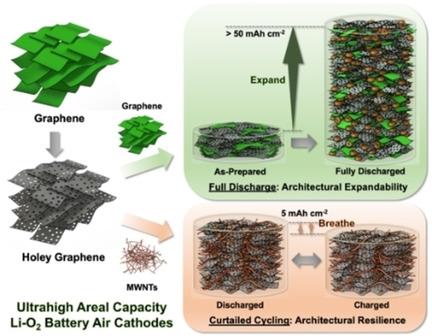当前位置:
X-MOL 学术
›
Batteries Supercaps
›
论文详情
Our official English website, www.x-mol.net, welcomes your
feedback! (Note: you will need to create a separate account there.)
Architecture Transformations of Ultrahigh Areal Capacity Air Cathodes for Lithium‐Oxygen Batteries
Batteries & Supercaps ( IF 5.1 ) Pub Date : 2020-09-22 , DOI: 10.1002/batt.202000201 Louisa C Greenburg 1 , Christian O Plaza-Rivera 1 , Jae-Woo Kim 2 , John W Connell 3 , Yi Lin 4
Batteries & Supercaps ( IF 5.1 ) Pub Date : 2020-09-22 , DOI: 10.1002/batt.202000201 Louisa C Greenburg 1 , Christian O Plaza-Rivera 1 , Jae-Woo Kim 2 , John W Connell 3 , Yi Lin 4
Affiliation

|
Lithium‐oxygen (Li−O2) batteries have the highest known theoretical energy density but are still not practical for use in most applications. A key aspect that has been largely overlooked in the field is how to improve the reversible areal capacity of the air cathode to a competitive level (>5–10 mAh cm−2). For carbon‐based air cathodes, increase of areal capacity requires a corresponding increase of carbon mass loading. As a result, the electrode thickness also increases which impedes the mass transport of Li ions and O2 needed for battery reactions. It is therefore imperative to investigate not only the air cathode composition, but also its dimensional architecture, for the effective function of high areal capacity Li−O2 batteries. Herein, we present the use of several representative additives of carbon‐based nanomaterials, including carbon black, two different diameters of multi‐walled carbon nanotubes, and graphene materials from two sources, into a high mass loading (10 mg cm−2), ultrathick (∼100 μm) air cathode architectural platform matrix based on dry‐compressed holey graphene. The performances of these all‐carbon composite air cathodes differ from that of the neat holey graphene, but not by a simple addition or subtraction effect. In addition, the additive effects to full discharge and curtailed cycling experiments are significantly different. The presented results strongly suggest that the architectural volume expandability is critical for the full discharge properties. However, the cycling performance depends more upon the resilience of the air cathode architecture (“breathability”), which does not necessarily correlate with its expandability.
中文翻译:

锂氧电池超高容量空气阴极的架构转换
锂氧(Li-O 2)电池具有最高的理论能量密度,但在大多数应用中仍不实用。在该领域中,一个被广泛忽略的关键方面是如何将空气阴极的可逆面容量提高到竞争水平(> 5-10 mAh cm -2)。对于碳基空气阴极,增加面积容量需要相应增加碳质量负荷。结果,电极厚度也增加,这阻碍了电池反应所需的锂离子和O 2的质量传递。因此,必须研究空气阴极组成及其尺寸结构,以实现高面容量Li-O 2的有效功能。电池。在此,我们介绍了几种具有代表性的碳基纳米材料添加剂的使用,包括炭黑,两种不同直径的多壁碳纳米管以及两种来源的石墨烯材料在高质量负载(10 mg cm -2)下的使用。),基于干压缩多孔石墨烯的超厚(〜100μm)空气阴极建筑平台基质。这些全碳复合空气阴极的性能与纯净多孔石墨烯的性能不同,但不是简单的加减作用。此外,对完全放电和缩短循环实验的累加效果也有很大不同。提出的结果强烈表明建筑体积的可扩展性对于全部放电性能至关重要。然而,循环性能更多地取决于空气阴极结构的弹性(“透气性”),其不一定与其可膨胀性相关。
更新日期:2020-09-22
中文翻译:

锂氧电池超高容量空气阴极的架构转换
锂氧(Li-O 2)电池具有最高的理论能量密度,但在大多数应用中仍不实用。在该领域中,一个被广泛忽略的关键方面是如何将空气阴极的可逆面容量提高到竞争水平(> 5-10 mAh cm -2)。对于碳基空气阴极,增加面积容量需要相应增加碳质量负荷。结果,电极厚度也增加,这阻碍了电池反应所需的锂离子和O 2的质量传递。因此,必须研究空气阴极组成及其尺寸结构,以实现高面容量Li-O 2的有效功能。电池。在此,我们介绍了几种具有代表性的碳基纳米材料添加剂的使用,包括炭黑,两种不同直径的多壁碳纳米管以及两种来源的石墨烯材料在高质量负载(10 mg cm -2)下的使用。),基于干压缩多孔石墨烯的超厚(〜100μm)空气阴极建筑平台基质。这些全碳复合空气阴极的性能与纯净多孔石墨烯的性能不同,但不是简单的加减作用。此外,对完全放电和缩短循环实验的累加效果也有很大不同。提出的结果强烈表明建筑体积的可扩展性对于全部放电性能至关重要。然而,循环性能更多地取决于空气阴极结构的弹性(“透气性”),其不一定与其可膨胀性相关。











































 京公网安备 11010802027423号
京公网安备 11010802027423号